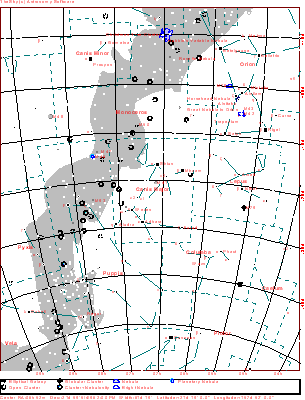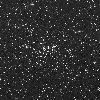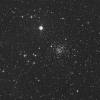
| Home | Deepsky Atlas | TheAstronews | Links | Solar System | ||||||

Hawaiian Astronomical SocietyConstellations: Canis Major -- One of Orion's Dogs |
||||||||||
That shift in dates is caused by a phenomenon called precession, a 26,000 year circular wobble of the Earth as it rotates. Go further back in time (about 3000 B.C.E.) and Sirius rises just before the sun in early Summer. The ancient Egyptians used the predawn rising of Sirius (called the heliacal rising) to predict the flooding of the Nile.

Click the map for a 909x1199 version of the above. Click here for a map better suited for use in the field.

This a more detailed view of the constellation. The map displays stars to magnitude 10, and deepsky objects to magnitude 12. Click here for a map better suited for use in the field.
 87k JPEG Caldwell 64 (NGC2362) is the open cluster designed for all those apochromatic refractors. Centered on Tau Canis Majoris, the cluster is an exquisite jewel that rewards clean, high contrast optics. Dreyer calls this mag. 4.1 cluster fairly large (8'), and rich, with about 60 stars at mags. 4-13. Image from "Le super NGC Catalogue!" Image has the look of a Digital Sky Survey download. 87k JPEG Caldwell 64 (NGC2362) is the open cluster designed for all those apochromatic refractors. Centered on Tau Canis Majoris, the cluster is an exquisite jewel that rewards clean, high contrast optics. Dreyer calls this mag. 4.1 cluster fairly large (8'), and rich, with about 60 stars at mags. 4-13. Image from "Le super NGC Catalogue!" Image has the look of a Digital Sky Survey download.
|
 87k JPEG Caldwell 58 (NGC2360) is one of many lovely open clusters in Canis Major. Located 3.4° east of Gamma Canis Majoris, Dreyer calls this mag. 4.1 cluster very large (13'), fairly condensed, and rich, with about 80 stars at mags. 9-12. Image from "Le super NGC Catalogue!" Image has the look of a Digital Sky Survey download. 87k JPEG Caldwell 58 (NGC2360) is one of many lovely open clusters in Canis Major. Located 3.4° east of Gamma Canis Majoris, Dreyer calls this mag. 4.1 cluster very large (13'), fairly condensed, and rich, with about 80 stars at mags. 9-12. Image from "Le super NGC Catalogue!" Image has the look of a Digital Sky Survey download.
|
The central mag. 11 star is a Wolf-Rayet. These are stars several times the size of the sun, and thousands of times more luminous. They are also either extremely turbulent, or throwing off masses of material. Image on the left from the Anglo-Australian Telescope, by way of the Deep Sky Corner. Image on the right is from the Digital Sky Survey.
|
 98k JPEG M41 (NGC2287) is a lovely open cluster located 4° south of Sirius. Dreyer calls it very large (38'), bright (mag. 4.5), fairly uncondensed, with plenty of stars at mag. 8 and fainter. This is a superb cluster, with stars of contrasting colors. Image from the Digital Sky Survey. 98k JPEG M41 (NGC2287) is a lovely open cluster located 4° south of Sirius. Dreyer calls it very large (38'), bright (mag. 4.5), fairly uncondensed, with plenty of stars at mag. 8 and fainter. This is a superb cluster, with stars of contrasting colors. Image from the Digital Sky Survey.
|
 75k JPEG NGC2243 (Bennett 36a) is an open cluster located in south-eastern Canis Major, 1.3° NNW of Lambda Canis Majoris. Dreyer calls this a fairly faint cluster of mag. 9-11 stars. Telescopes over 12" may see over 100 stars. Small telescopes (3"), or poor conditions will show only one to two stars embedded in a faint haze. 75k JPEG NGC2243 (Bennett 36a) is an open cluster located in south-eastern Canis Major, 1.3° NNW of Lambda Canis Majoris. Dreyer calls this a fairly faint cluster of mag. 9-11 stars. Telescopes over 12" may see over 100 stars. Small telescopes (3"), or poor conditions will show only one to two stars embedded in a faint haze.
|
If you have any questions about the Hawaiian Astronomical Society
please
(link requires javascript).